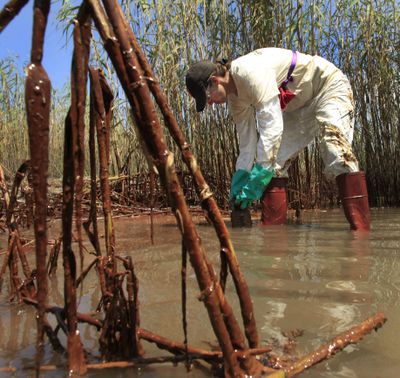Oil leak worse than thought
4 million gallons spilling daily, expert testifies

WASHINGTON – The latest glimpse of video footage of the oil spill deep under the Gulf of Mexico indicates that around 95,000 barrels, or 4 million gallons, a day of crude oil may be spewing from the leaking wellhead, 19 times the previous estimate, an engineering professor told Congress on Wednesday.
The figure of 5,000 barrels, or 210,000 gallons, a day that BP and the federal government have been using for weeks is based on observations of the surface slick made by satellites and aircraft. Even NASA’s satellite-based instruments, however, can’t see deep into the waters of the gulf, where much of the oil from the gusher seems to be floating. The well is 5,000 feet below the surface.
Adm. Thad Allen, the commandant of the Coast Guard, said in an interview Wednesday that he’d had many conversations over the past week or more with other government science officials about how to get a more precise calculation of the flow, a better estimate of the total oil in the Gulf since the April 20 explosion and an accurate assessment of what’s happening to the oil on the surface.
Allen said his advisers are considering putting sensors near the leak that would give a better understanding of the amount of oil entering the water.
Allen announced plans to assemble the team of experts to measure the size of the spill during hearings on Tuesday. NOAA Administrator Jane Lubchenco said that it would be important, but difficult, to figure out the amount of oil from the ruptured wellhead.
Steve Wereley, an associate professor of mechanical engineering at Purdue University in West Lafayette, Ind., earlier this month made simple calculations from a single video BP released on May 12 and calculated a flow of 70,000 barrels a day, NPR reported last week.
On Wednesday, Wereley told a House of Representatives Energy and Commerce subcommittee that his calculations of two leaks that are on videos BP released on Tuesday showed 70,000 barrels from one leak and 25,000 from the other.
He said the margin of error was about 20 percent, making the spill between 76,000 and 104,000 barrels a day. However, Wereley said he’d need to see videos that showed the flow over a longer period to get a better calculation of the mix of oil and gas from the wellhead.
Rep. Ed Markey, D-Mass., who led the hearing, said he’d work to get that information from BP.
“The true extent of this spill remains a mystery,” Markey said. He said BP had said that the flow rate was not relevant to the cleanup effort. “This faulty logic that BP is using is … raising concerns that they are hiding the full extent of the damage of this leak.”